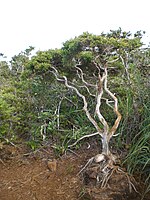Mount Hamiguitan Range Wildlife Sanctuary
The Mount Hamiguitan range, with an area of 6,834 hectares (68.34 km), was declared a national park and a wildlife sanctuary in 2003. In 2014, the park was inscribed as a UNESCO World Heritage Site, becoming the first in Mindanao and the sixth in the Philippines.
Mount Hamiguitan is part of the Eastern Mindanao Biodiversity Corridor. Conservation of the mountain range is a multisectoral effort done involving the provincial government of Davao Oriental, the Department of Environment and Natural Resources, local communities, and indigenous people.
Geography
Mount Hamiguitan is located in the province of Davao Oriental in the southeastern part of the island of Mindanao, Philippines. It occupies the land area within the political boundaries of Mati, San Isidro, and Governor Generoso.
Flora and fauna
Plants
Inventory of flora species in the mountain and its vicinity showed that its montane forest has the highest species richness of plants with 462 species, followed by its dipterocarp forest with 338 species, mossy forest with 246 species and agro-system with 246 species. The mountain also harbors 45 species of orchids, 23 of which are endemic to the Philippines. Some of the plants commonly found on Mount Hamiguitan include the following:


- Leptospermum flavescens
- Wendlandia nervosa
- Tristaniopsis micrantha
- Dacrydium elatum
- Calophyllum blancoi
- Symplocos polyandra
- Almaciga (Agathis philippinensis)
- Elaeocarpus verticillatus
- Patersonia lowii
- Astronia lagunensis
- Nepenthes alata (sensu lato)
- Nepenthes hamiguitanensis
- Nepenthes justinae
- Nepenthes micramphora
- Nepenthes peltata
- Schizaea inopinata
- Schizaea malaccana
- Paphiopedilum ciliolare
- Dipodium paludosum
- Epigeneium sp.
- Dendrochilum longilabre
- Dendrochilum tenellum
- Dendrochilum sp. (unknown species)
- Macodes petola
- Coelogyne chloroptera
- Bulbophyllum sp.
- Appendicula sp.
- Gleichennia hirta
- Drimys piperita
- Hydnophyton sp.
- Dilochia deleoniae
- Lindsaea hamiguitanensis
- Ceratostylis latipetala
- Bulbophyllum colubrimodum
Animals
The International Union for Conservation of Nature (IUCN) Red List has identified at least 11 endangered vertebrate species. The Philippine Council for Agriculture, Forestry and Natural Resources and Development (PCARRD) reported that the mountain is inhabited by five endangered species, 27 rare species, 44 endemic species and 59 economically important species. The following species can be found in the area:
- Philippine eagle (Pithecophaga jeffreyi)
- Giant golden-crowned flying fox (Acerodon jubatus)
- Philippine forest roundleaf bat (Hipposideros obscurus)
- Philippine tarsier (Tarsius syrichta)
- Philippine warty pig (Sus philippensis)
- Philippine brown deer (Cervus mariannus)
- Fischer's pygmy fruit bat (Haplonycteris fischeri)
- Asian palm civet (Paradoxurus hermaphroditus)
- Tawitawi brown-dove (Phapitreron cinereiceps)
- Tarictic hornbill (Penelopides panini)
- Grey-hooded sunbird (Aethopyga primigenius)
- Giant scops-owl or Mindanao eagle-owl (Mimizuku gurneyi)
- Batomys hamiguitan (a yellow-brown furry-tailed rat species endemic to the area)
Designations
In 2004, Mount Hamiguitan was declared as a wildlife sanctuary through the Mount Hamiguitan Law which was enacted by President Gloria Macapagal-Arroyo under the initiative of senator Loren Legarda.
In June 2014, the Mount Hamiguitan Range Wildlife Sanctuary was added to the UNESCO list of World Heritage Sites. Prior to this, the site has already been declared an ASEAN Heritage Park.
Notes
- ^ "World Ribus - Philippines". World Ribus. Retrieved December 22, 2024.
- ^ de Ferranti, Jonathan; Maizlish, Aaron (2005). "Philippine Mountains – 29 Mountain Summits with Prominence of 1,500 Meters or Greater". peaklist.org. Retrieved January 9, 2009.
- ^ "Nepenthes: Species in the Philippines". The Carnivorous Plant FAQ v. 11.5. The International Carnivorous Plant Society. 2009. Archived from the original on January 22, 2009. Retrieved January 9, 2009.
- ^ Amoroso, Victor B.; Aspiras, Reyno A. (2011). "Hamiguitan Range: A Sanctuary for Native Flora". Saudi Journal of Biological Sciences. 18 (1): 7–15. doi:10.1016/j.sjbs.2010.07.003. PMC 3730927. PMID 23961098.
- ^ "Davao Oriental Wants Hamiguitan Declared as World Heritage Site". GMA News Online. May 5, 2008. Archived from the original on March 10, 2011. Retrieved January 9, 2009.
- ^ "Nine New Sites Inscribed on World Heritage List". UNESCO. June 23, 2014. Archived from the original on June 25, 2014. Retrieved June 23, 2014.
- ^ Republic Act No. 9303 – via Supreme Court E-Library.
- ^ "Mount Hamiguitan Range Wildlife Sanctuary". UNESCO World Heritage Centre. Retrieved February 9, 2022.
- ^ Quismundo, Tarra (June 25, 2013). "Mt. Hamiguitan Being Considered as Unesco World Heritage Site". Inquirer.net. Retrieved December 1, 2020.
- ^ "Mount Hamiguitan Range Wildlife Sanctuary". IUCN World Heritage Outlook. Retrieved December 1, 2020.
- ^ Acma, Florfe M.; Mendez, Noe P. (2018). "Noteworthy Records of Philippine Endemic Gingers (Zingiberaceae) in the Buffer Zone of Mt. Hamiguitan Range Wildlife Sanctuary, Davao Oriental, Philippines". Environmental and Experimental Biology. 16 (2): 111–115. doi:10.22364/eeb.16.10.
- ^ McPherson, Stewart (2009). Pitcher Plants of the Old World. Vol. 1–2. Poole: Redfern Natural History Productions.
- ^ Gronemeyer, T., A. Wistuba, V. Heinrich, S. McPherson, F. Mey & A. Amoroso 2010. Nepenthes hamiguitanensis (Nepenthaceae), a new pitcher plant species from Mindanao Island, Philippines. In: S.R. McPherson Carnivorous Plants and their Habitats. Redfern Natural History Productions Ltd., Poole. pp. 1296–1305.
- ^ Gronemeyer, Thomas; Suarez, Wally; Nuytemans, Herman; Calaramo, Michael; Wistuba, Andreas; Mey, François; Amoroso, Victor (2016). "Two New Nepenthes Species from the Philippines and an Emended Description of Nepenthes ramos". Plants. 5 (2). 23. doi:10.3390/plants5020023. PMC 4931403. PMID 27164153.
- ^ "Republic Act No. 9303". Official Gazette of the Republic of the Philippines. July 30, 2004. Archived from the original on November 22, 2017. Retrieved March 1, 2024.
- ^ "Six New Sites Inscribed on World Heritage List". UNESCO. June 23, 2014. Retrieved February 9, 2022.
References
- Amoroso, V.B. & R.A. Aspiras 2011. Hamiguitan Range: a sanctuary for native flora. Saudi Journal of Biological Sciences 18(1): 7–15. doi:10.1016/j.sjbs.2010.07.003
External links
 Media related to Mount Hamiguitan at Wikimedia Commons
Media related to Mount Hamiguitan at Wikimedia Commons